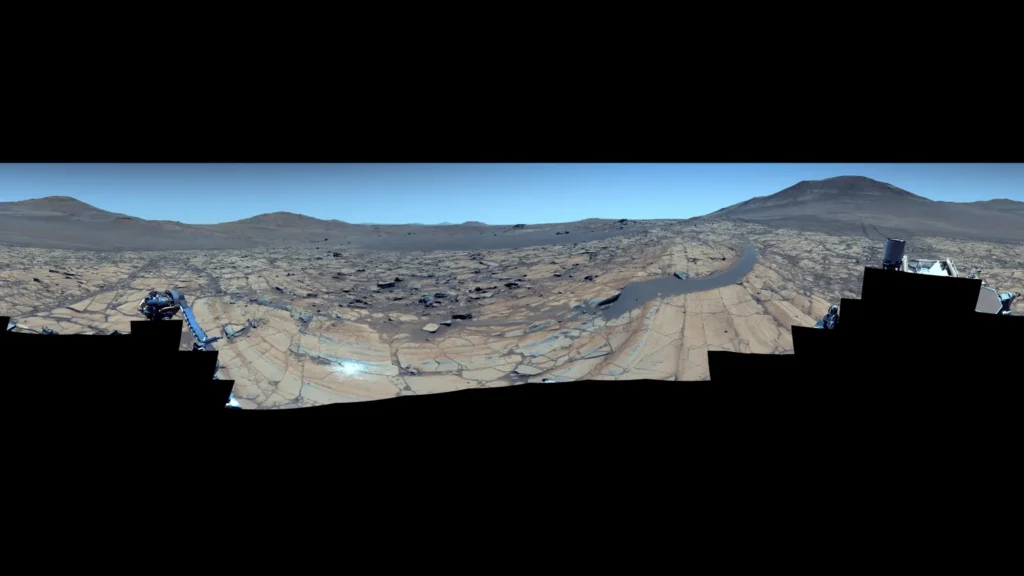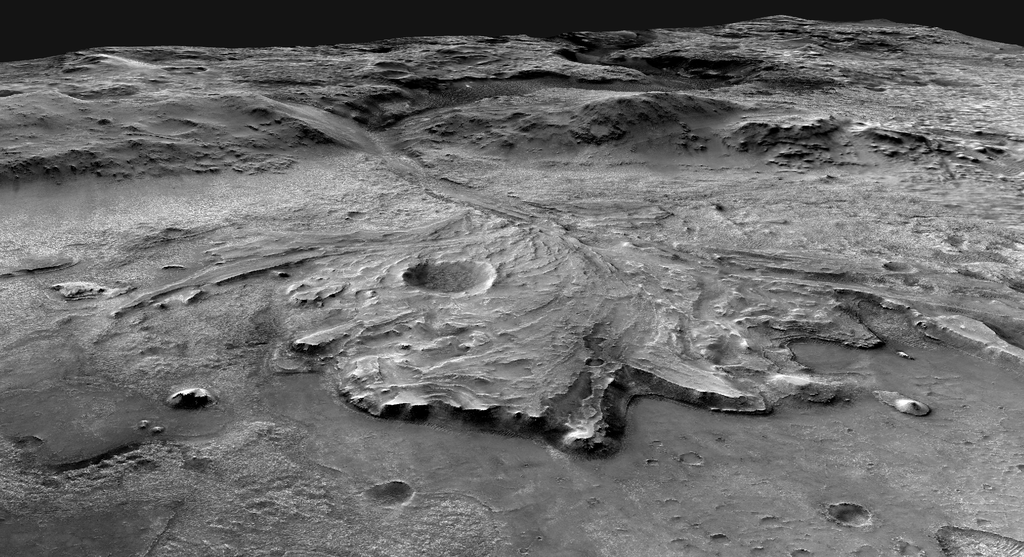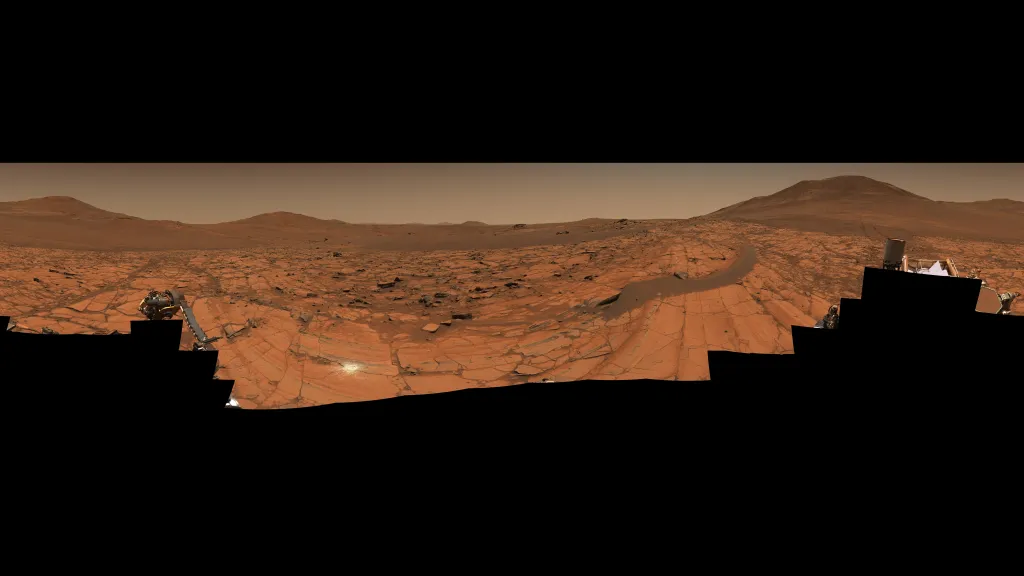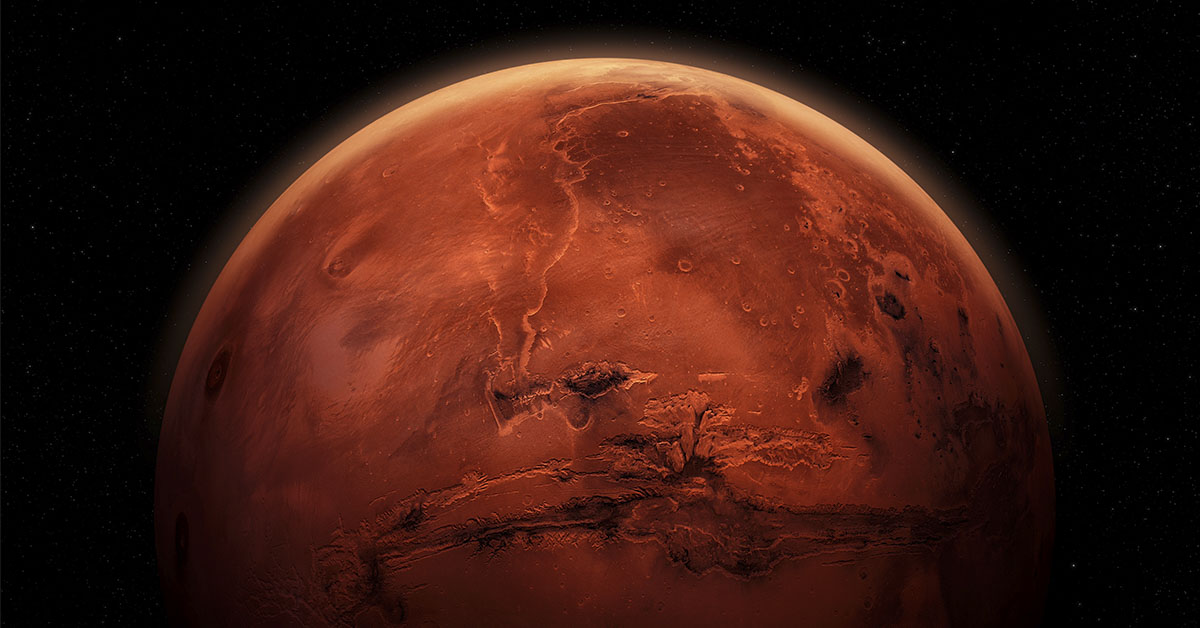NASA’s Perseverance rover has produced its sharpest visual record yet, capturing a wide panoramic view that might remind you of the American Southwest. This landscape, however, sits more than 140 million miles away on Mars and displays something uncommon. Brilliant blue skies that resemble Earth’s atmosphere stretch across the Mar’s horizon.

If you were actually standing there, the view would look quite different. The natural-color version of the same scene shows the more familiar reddish tones we expect from Mars, where fine dust particles usually tint everything in shades of rust and amber. The blue skies appear only through the rover’s color-enhanced processing. The rover captured this view at a location scientists call “Falbreen.” The mosaic was built from 96 separate photographs taken during the rover’s 1,516th day exploring the Red Planet.
A Familiar Sky in a Distant World

Perseverance worked for years to reach this viewpoint. Traveling across Jezero Crater’s floor before climbing the western rim over 3½ months. Scientists chose Jezero for their research, a 28-mile-wide ancient lake, because this seemed ideal for finding signs of tiny life forms that might have existed billions of years ago. The rover ascended 1,640 vertical ft up steep, slippery slopes to reach the crater rim in December 2024, where it can now study ancient Martian crust rocks among the oldest in the solar system.
Months later, on May 26, 2025 (sol 1,516, or the 1,516th Martian day of the mission), conditions at Falbreen were perfect for photography. “The relatively dust-free skies provide a clear view of the surrounding terrain,” explains Jim Bell, who leads the camera team at Arizona State University. Such clear conditions are rare on Mars, where dust storms often cover huge areas for weeks.
The rover’s Mastcam-Z camera system, which can zoom and focus like a high-tech telescope, captured 96 photos using different colored filters. Creating new 360-degree panoramic images showing 40 miles of terrain on Mars. Many people have said how the blue skies in this image look just like Earth’s. But this is only because computer processing brightens certain colors to help scientists see land features better, creating the blue sky effect. In reality, Mars’ skies are reddish from iron dust particles.
Rocks That Tell Stories
About 14 ft from the rover sits a large, dark rock perched on a crescent-shaped sand hill. Scientists call this a “float rock”. They say, it formed somewhere else and traveled here by landslide, flowing water, or Martian winds. Researchers think it settled before the surrounding sand accumulated around its base.
Near the center of the image, a bright white 2-inch-wide circle marks where the rover drilled into another rock on May 22. The rover then spent two days studying this exposed material. Using tools on its robotic arm to decide whether it was worth taking a full sample. This was the rover’s 43rd investigation since landing, part of the search for signs of ancient life.
Scientists are quite excited about Falbreen. The area contains some of the oldest rocks Perseverance has explored, possibly older than the crater where it first landed. These ancient samples could give scientists new information about whether conditions on Mars once supported life billions of years ago.
Layers of Time Written in Stone

Mars panorama reads like pages from an old story. About halfway up, a clear line sweeps across the landscape where two different rock types meet. Telling us different chapters in Mars’ history.
On one side, lighter rocks closer to the rover contain olivine, a green mineral that forms when hot volcanic material cools. On the other side, darker formations rich in clay minerals formed when rocks sat in water for millions of years. These clay rocks may be older than Jezero Crater itself. Showing that Mars had flowing water over 3.7 billion years ago.
The rover has also left its own story in this landscape. You can see Perseverance’s wheel tracks curving across the right side of the photo. About 300 ft away, they turn left and disappear toward a previous stop called “Kenmore,” marking each step in our exploration of another world.
From Rover Tracks to Human Footsteps
This view from Falbreen is more than just another stunning image from Mars. As NASA prepares its Artemis program to return astronauts to the Moon and eventually send crews to Mars. Acting NASA Administrator Sean Duffy says that views like this give us ‘just a glimpse of what we’ll soon witness with our own eyes.’
The blue skies of Falbreen may be artificial, but they represent something important about our growing connection to Mars. Every image, sample, and discovery makes the distant planet feel less strange to us. This feeling of familiarity might be exactly what we need as we get closer to sending humans there. Missions like Perseverance help build this connection.
From the rim of Jezero Crater, Perseverance continues to mark new milestones in space exploration. Mars is harsh and deadly, with radiation that threatens human health and an atmosphere too thin to breathe. These challenges won’t stop us, though. We are learning its secrets, one rover mission at a time, preparing for the day humans will walk on its surface.

